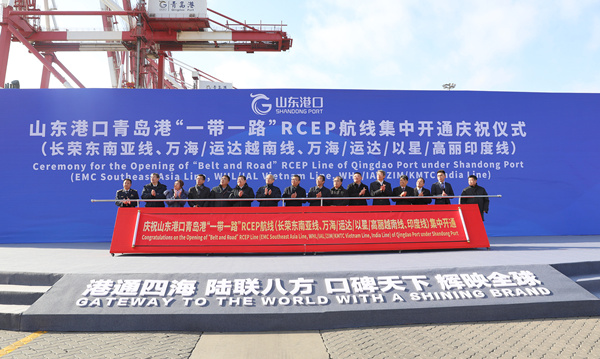Qingdao Port opens new international routes
 0 Comment(s)
0 Comment(s) Print
Print E-mail China.org.cn, February 14, 2021
E-mail China.org.cn, February 14, 2021

Qingdao Port of Shandong Port Group opened three new international sea routes on Jan. 19, bringing the number of the company's container routes to 305.
The new routes — EMC Southeast Asia line, WHL/IAL Vietnam line and WHL/IAL/ZIM/KMTC India line — will link Qingdao Port with regions and countries along the Belt and Road and with partner countries of the Regional Comprehensive Economic Partnership (RCEP), a major free trade agreement between Asia-Pacific nations signed last November.
As this year marks the launch of China's 14th Five-Year Plan (2021-25), the opening of the three routes is a decisive measure in implementing the new development concept, serving the new development paradigm and accelerating high-quality development, said Li Fengli, general manager of Shandong Port Group.
According to Li, the new routes will speed up the construction of a consumer goods distribution center in northern China, and make it possible to directly deliver products from Southeast Asian countries to the economic hinterland of Shandong province and enrich food supplies for the local people.
Shandong Port will continue to follow its development strategy of east-west connections and land-sea linkages, further establishing maritime cooperation with more ports and building a dynamic maritime industry ecosystem. It will contribute its strength to boosting high-quality regional economic development, building a nautical bridgehead for BRI and RCEP partner countries, and serving national economic growth, he said.
In 2020, the cargo throughput of Shandong Port exceeded 1.4 billion metric tons, and its container traffic exceeded 31 million TEUs. Despite the impact of the COVID-19 pandemic, it achieved growth against a general world downward trend and ranked among the best coastal ports in China.
Li added that the signing of the RCEP provided a rare opportunity for Shandong Port to deepen cooperation with Japan, the Republic of Korea, Southeast Asia and other countries and regions. The port would be integrated into the country's new development paradigm of "big circulation" and "dual circulation" to stabilize foreign trade, maintain smooth flow, and promote development.
Together with major shipping companies, it will make every effort to increase the density of advantageous route groups and accelerate the building of an international shipping hub in Northeast Asia.
Su Jianguang, general manager of Qingdao Port, believed that the opening of the three routes marked an important achievement in jointly promoting the implementation of the RCEP agreement.
Representatives of relevant shipping agencies and marine companies also held high expectations for the new routes, as the EMC Southeast Asia line will build a highly efficient and low-cost maritime logistics channel connecting with Malaysia; the WHL/IAL Vietnam line is Qingdao Port's first Southeast Asia cold-chain direct express route, which will bring imported food such as fruit from Vietnam to the port within only five days; WHL/IAL/ZIM/KMTC India line will further increase the density of direct routes from Qingdao Port to South Asia.
Liu Jicheng, deputy secretary-general of Qingdao Municipal Government, believed the shipping network would lead to an upgrade of a "seaward golden channel" connecting Shandong Port with BRI countries in Southeast Asia and Middle Asia as well as RCEP partner countries, helping to achieve high-quality economic cooperation with ASEAN countries.
Cai Zhongtang, executive deputy general manager of Shandong Port Group, said that, in order to speed up regional economic and trade cooperation and ensure the smooth flow of the industrial and supply chains, the company had successively issued significant policies to accelerate the breakthrough development of containers and support the expansion of container routes.
Ship arrivals and departures are now more efficient at Qingdao Port, the loading and unloading efficiency further improved, and online services further expanded, all contributing to a better business environment here, he said.
Content created in partnership with Science and Technology Daily.






Go to Forum >>0 Comment(s)